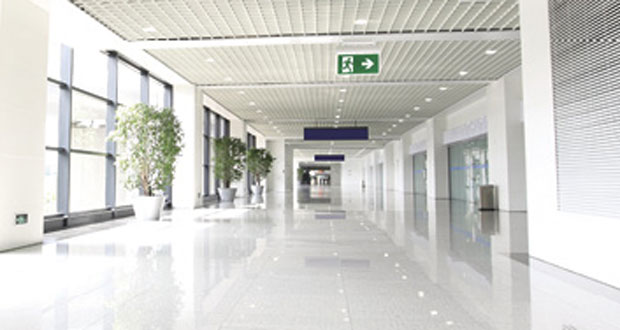 Regular testing of emergency lighting is a safety-critical process that is central to a building’s fire safety compliance. René Joppi, Managing Director at Mackwell, says the design and installation of emergency lighting should be in line with the building’s risk assessment and local legislation
Regular testing of emergency lighting is a safety-critical process that is central to a building’s fire safety compliance. René Joppi, Managing Director at Mackwell, says the design and installation of emergency lighting should be in line with the building’s risk assessment and local legislation
For smaller facilities management teams in charge of a number of buildings, the mandatory testing and maintenance of a lighting system as well as routine physical inspections of the luminaires and associated components is not a quick task. Traditionally, this testing process has been completed manually, involving a key switch on a wall, with maintenance engineers physically observing whether systems are still working.
Today this testing can be completely automated, and in new build projects, it has been common for several years for automatic emergency testing systems to be written into the building specification. However, difficulty in retrofitting such systems to existing buildings has caused testing in those structures to remain manual. To further complicate matters, newer smart buildings might be designed around converged IP networks, with devices connected via ethernet, rather than having traditional mains power feeds. These different scenarios create complexity for those managing estates consisting of both old and new buildings as there are a multitude of testing models and scenarios to consider when managing emergency lighting.
Understanding manual testing
Manual testing consists of breaking the supply to a section of emergency lighting and visually checking the light output at the start and end of the expected duration. An engineer must visually inspect each luminaire for damage or any impairment of the desired light. Once completed, all results must be logged and maintenance scheduled for any failures found.
Commercial buildings such as student accommodation blocks, office premises or hospitals employ many people while also accommodating members of the public. It would not be unusual for them to have over 1,000 emergency lighting fixtures installed, which must all be maintained, cleaned, visually inspected, tested, and recorded into the building log book. These are all legal requirements to ensure the safety of the occupants in times of evacuation.
However, manual testing can be disruptive to employees and an engineer must be available out of hours to conduct tests during a period of low risk, ideally when the building is unoccupied.
Automatic testing systems offer a solution, but being a critical part of the fire safety risk assessment, organisations can’t simply shirk their responsibilities on emergency lighting tests. Instead, they need to be vigilant in streamlining tasks even in older buildings where testing is not as quick, or as easy.
Testing systems powered by cloud technology
 By deploying an intelligent operating system with diagnostic capabilities, a high level of control can be achieved effectively and efficiently in both new builds and older structures. Protocols such as Digital Addressable Lighting Interface (DALI) allows for additional commands and functions from each manufacturer to improve user experience. Additional functions vary greatly but can include, on board diagnostics of the luminaire and extended controls to inhibit emergency or periodically drain the batteries to increase product life.
By deploying an intelligent operating system with diagnostic capabilities, a high level of control can be achieved effectively and efficiently in both new builds and older structures. Protocols such as Digital Addressable Lighting Interface (DALI) allows for additional commands and functions from each manufacturer to improve user experience. Additional functions vary greatly but can include, on board diagnostics of the luminaire and extended controls to inhibit emergency or periodically drain the batteries to increase product life.
Both simple to use and intuitive with live system status diagnostics for instant information, these systems allow facilities managers to view reports remotely through internet connection via a variety of networking options. Furthermore, users are able to connect all systems across various sites to one central cloud dashboard that shows exactly where each emergency lighting solution is located. It automates testing and identifies any faults or potential risks, and even measures and flags which batteries need to be replaced.
 This solution is particularly helpful when it comes to managing varying types of buildings such as old, new, refurbished, smart or non-smart. Each individual building will have varying testing needs, based on its own fire risk assessment and the type of structure it is as outlined above. Not only do these cloud-based devices help facilities managers to diversify the types of buildings they are managing at one time, but also the types of solutions going into each building.
This solution is particularly helpful when it comes to managing varying types of buildings such as old, new, refurbished, smart or non-smart. Each individual building will have varying testing needs, based on its own fire risk assessment and the type of structure it is as outlined above. Not only do these cloud-based devices help facilities managers to diversify the types of buildings they are managing at one time, but also the types of solutions going into each building.
Where existing solutions have been able to deal with around 100 devices connected to one cloud-based panel, there are now new advancements in the market that are able to accommodate over 1,000 devices on a single panel. From a scaling perspective, this is a revolutionary step.
The future is automated
It’s clear that automatic testing of emergency lighting offers peace of mind that a building is safe for all employees or residents and compliant to all regulations and law, but also the potential monetary savings. In labour alone, a system can save many hours of work.
It must be said that automatic test systems are not a substitute for routine maintenance. Visual inspection of both the emergency lighting components together with acknowledgment of any building changes must be undertaken routinely.  Automatic test systems serve as a vital and welcome compliment to assist facilities management teams to carry out this demanding and vital role diligently, conscientiously and accurately.
Automatic test systems serve as a vital and welcome compliment to assist facilities management teams to carry out this demanding and vital role diligently, conscientiously and accurately.





